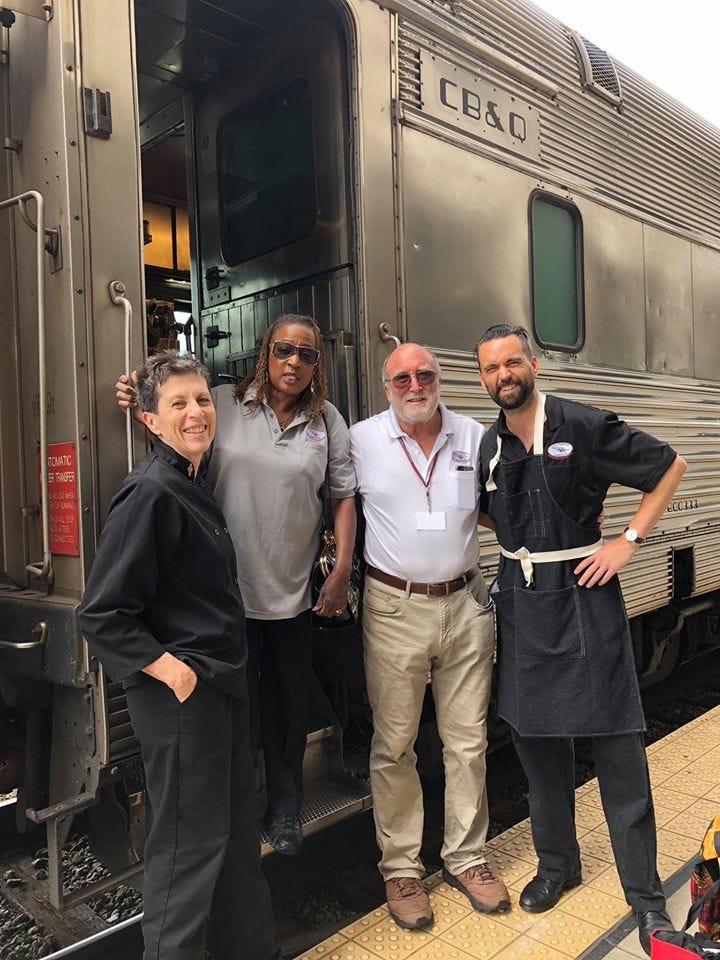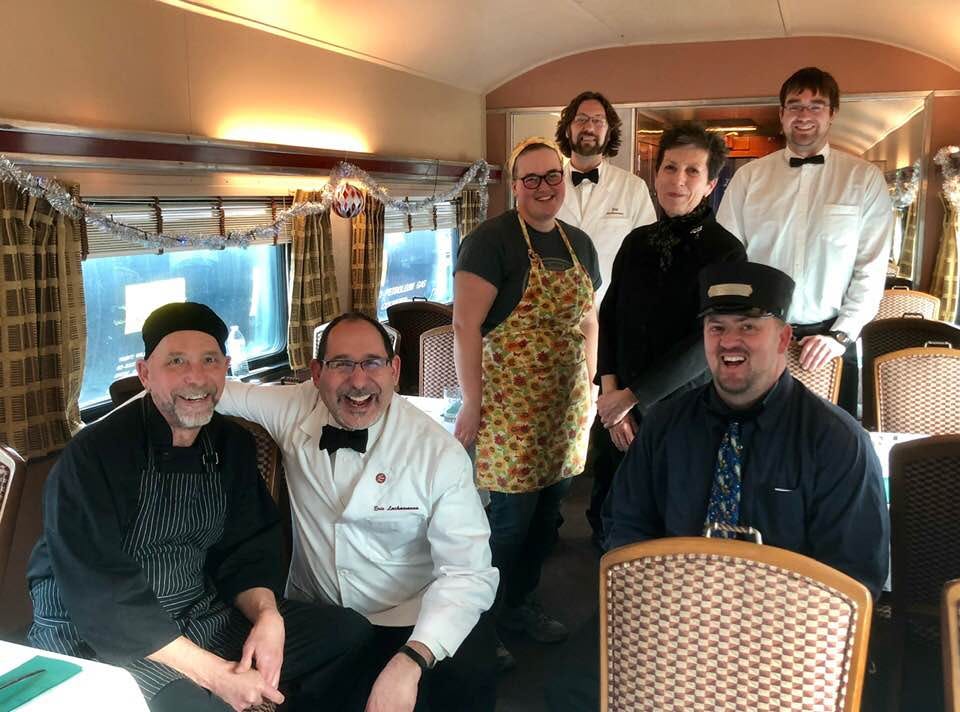“I can make a difference here”
In the heyday of passenger railroading, riding the train was just a part of multisensory experience. In their time onboard, the passengers were entertained by performers in the lounge car, awestruck by the views from a skytop dome or from the rear of a train, and were fed some of the most exceptional meals they’d ever have the pleasure of tasting. Nowadays, things are quite different to say the least. Having worked in the private varnish industry, I can say with certainty that a well-prepared meal that fits with the genre of the trip makes all the difference, and today’s spotlight is here to back me up. Today on Behind the Throttle, we go into the kitchen of a private passenger car with Fran Phillips.
Fran stands behind the Silver Solarium as it brings up the markers of a 2017 excursion led by the N&W 611. Photo by Lawrence Biemiller.
Riding the rails has always been part of Fran’s life. As a longtime commuter aboard the Long Island Railroad, Fran found out she could avoid changing trains and ensure she would have a seat for a whole train ride by boarding the train at the Long Island City Railyard. While waiting for her train, she often ended up chatting with the laborers in the yard, and soon called them her friends. These men taught Fran some of the basics of railroading, and even taught her skills like how to detrain a moving railcar – a feat she mastered in high-heels! Her new friends in the trainyard sparked her casual interest in railroading, as she observed not only the interesting technology but the sense of community that formed around the job. In 1985 Fran took her first trip on a private car, an eye-opening experience that changed her mind about railroading. Up until that point, Fran seldom rode trains for pleasure, and while she appreciated the machinery, she did not see anything special about riding the rails. However, after this trip to Boston in 1985, while riding on the open-end platform of a luxury passenger car, she saw the magic of railroading right before her eyes. When her train arrived back in New York City, Fran was ill from the cold of being on the outer platform, but viewed it as a souvenir of the excursion. This was a side of railroading Fran had never seen before, one of luxury and fun; it was a train ride for the sake of journey, as opposed to just getting to a destination. Several years after this journey Fran once again embarked upon a private varnish for a journey to New Orleans. Riding onboard the Pullman Dover Harbor, Fran once again felt the magic of railroading beneath her feet, which prompted her to return to the Dover Harbor after another two years. This next trip was a cross-country journey that inspired Fran to begin volunteering with the organization that owned the railcar. After working a few trips over the course of two years, Fran worked her first solo trip in 2009 all the way from Washington DC to Denver. This trip was Fran’s trial by fire, where she had all the elements of passenger railroading thrown at her- and she loved every minute. Fran’s involvement in the industry mostly stemmed from her abilities in the kitchen, though she never considered herself anywhere near a professional cook. However, seeing the importance of a well-prepared meal onboard the trip, she saw herself taking on this role in the railcar: “I can make a difference here”, she explained to me. Following these trips with the Dover Harbor, Fran expanded her horizons and began volunteering to cook in more passenger cars across the eastern United States, seeing much of the countryside through the window in the kitchen.
Fran stands outside her humble steed with her fellow crewmates of the Silver Solarium in Oakland Califonia, following a cross-country journey.
Over her years of experience, Fran has amassed an impressive resume of the kitchens she’s conquered including that of the NYC Hickory Creek, the PRR Francis L Suter, Catalpa Falls and Business Car No.120, the Juniata Warrior Ridge, the Milwaukee Road Cedar Rapids, and many more. Cooking in these cars has shown her how important history is, and how little details make all the difference in the long run. Fran explained to me how when cooking on a different car, her menu will vary based on the lineage of the car. The respective menus of fallen railroads are true time capsules that illustrate the differences from life back when and life nowadays. By cooking authentic recipes from the archives of the railroads, Fran is able to recreate the scene of the bygone era. On the other hand, Fran also explained to me how her job is to cater to the desires of the guests on board. She’s cooked historic menus, contemporary meals similar to what is served today and even the blandest of meals for the most picky eaters. “There’s no one way to do this” she explained to me. Additionally, Fran outlined to me the juxtaposition that exists between a historic private car and a modern day Amtrak train, citing how the difference in levels of luxury is indicative of how passenger railroading has changed over the years, and more so the significance of preserving the legacy of rail travel.
Nowadays, Fran will frequently work with the Pullman Dover Harbor, creating feasts in a kitchen about the size of a walk-in closet. In addition to cooking in this car, Fran also volunteers as the Manager of Dining Car Services for the Erie Lackawanna Dining Car Preservation Society (ELDCPS), an organization that operates out of Scranton, PA. Fran was drafted to help with the ELDCPS to run the fleet of passenger cars owned by the organization. Fran stressed to me how important volunteers and donations are for groups like this one, especially with the COVID19 pandemic. In her time working on trains, Fran has seen how much a meal can add to the experience of riding the rails, both with historical value and the overall atmosphere. Keeping the tradition of dining cars alive is pivotal for the preservation of what made railroading so glorious in its heyday, and it’s Fran’s mission to preserve this element for years to come.
Fran poses with her colleagues of the ELDCPS in the dining room of car No. 469
Thank you for reading this edition of Behind The Throttle. Tune in next time for a look at the life of Linn Moedinger, a preservationist since day one. Until then, I’m Max Harris, and I’ll see you down the line.








